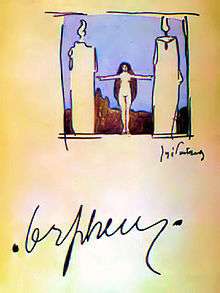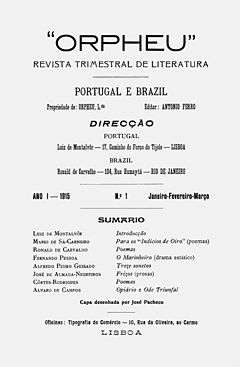Geração de Orpheu
| The literary journal ORPHEU | |
|---|---|
 Issue nr. 1, Jan-Feb-Mar 1915.
Cover design by José Pacheco |
The Geração de Orpheu (Orpheus's Generation) or Grupo de Orfeu refers to a group of men largely responsible for the introduction of Modernism to the arts and letters of Portugal through the vehicle of their tri-monthly publication, Orpheu (magazine) (1915).[1]
Following the lead of other European vanguard movements of the early twentieth century, and taking the Futurist Vladimir Maiakovsky's urgings to heart—and in the scintillating atmosphere of Lisbon's Baixa district—the poets Fernando Pessoa, Mário de Sá-Carneiro and Almada Negreiros, and the painters Amadeo de Souza-Cardoso and Guilherme de Santa-Rita joined together to form a journal of art and literature with principal function of agitating, subverting and scandalizing the Portuguese bourgeoisie and - by extension - all social conventions.
Orpheu

The journal's name, Orpheu was not chosen by accident - as in Greek myth, Orpheus (Orfeu in Portuguese) was the musician who, to save his wife Eurydice from Hades, had to travel from the world of the living with the stipulation to not looking back. It was this metaphor that was important to the men of the Geração de Orpheu: the not looking back, the forgetting, the relinquishing of the past and the concentration of attention and force to the journey ahead, to the future, for the "edification of Portugal in the twentieth century." After bursting onto the Portuguese literary scene in 1915, the journal folded due to financial insolvency, since the father of Sá-Carneiro, unwilling sponsor of the publication, refused the role. Only two issues were published (Jan-Feb-Mar and Apr-May-Jun, 1915). The third issue of Orpheu, that was already in printing proof, was lost during many years and it was finally recovered and published in 1984.[2]
After Orpheu
After the dissolution of Orpheu, the group however continued to publish in other literary journals. Most notably in 1917, Portugal Futurista came out with reproductions of Santa-Rita Pintor and Souza-Cardoso, along with the posthumous Futurist poems of Sá-Carneiro and some poetry by Pessoa, under the heteronym Álvaro de Campos. A small constellation of journals flourished with contributions from the Grupo, namely: Exílio (1916), Centauro (1916), Portugal Futurista (1917), Athena (1924–1925) and Presença (1927–1940) - the journal that ushered in the second wave of Portuguese Modernism.
Prominent members of the movement
- Amadeo de Souza-Cardoso, painter
- Almada Negreiros, writer / visual artist / choreographer
- Ângelo de Lima, writer
- António Ferro, writer
- Fernando Pessoa, writer
- Mário Saa, writer
- Mário de Sá-Carneiro, writer
- Santa-Rita Pintor, painter
References
- ↑ Orpheu at the Portuguese National Library issue nr. 1, January–February–March, and issue nr. 2, May–June–July, 1915.
- ↑ Orpheu 3, preparação do texto, introdução e cronologia de Arnaldo Saraiva. Lisboa: Edições Ática, 1984.
Bibliography
- AA.VV. (1989). ORPHEU, edição facsimilada. Lisboa: Contexto Editora. ISBN 972-575-076-4
- SARAIVA, António José and Óscar Lopes (1993). História da Literatura Portuguesa. Porto: Porto Editora, 17th ed. ISBN 972-0-30170-8
- MARTINS, Fernando Cabral (coord.) (2008). Dicionário de Fernando Pessoa e do Modernismo Português. Alfragide: Editorial Caminho. ISBN 978-972-21-1985-6
External links
- Portuguese National Library
- Orpheu at the Portuguese National Library
- Orpheu Nº1 at Gutenberg Project
- Orpheu Nº2 at Gutenberg Project